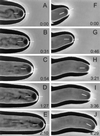A fungal kinesin required for organelle motility, hyphal growth, and morphogenesis
- PMID: 9436993
- PMCID: PMC25223
- DOI: 10.1091/mbc.9.1.89
A fungal kinesin required for organelle motility, hyphal growth, and morphogenesis
Abstract
A gene (NhKIN1) encoding a kinesin was cloned from Nectria haematococca genomic DNA by polymerase chain reaction amplification, using primers corresponding to conserved regions of known kinesin-encoding genes. Sequence analysis showed that NhKIN1 belongs to the subfamily of conventional kinesins and is distinct from any of the currently designated kinesin-related protein subfamilies. Deletion of NhKIN1 by transformation-mediated homologous recombination caused several dramatic phenotypes: a 50% reduction in colony growth rate, helical or wavy hyphae with reduced diameter, and subcellular abnormalities including withdrawal of mitochondria from the growing hyphal apex and reduction in the size of the Spitzenkörper, an apical aggregate of secretory vesicles. The effects on mitochondria and Spitzenkörper were not due to altered microtubule distribution, as microtubules were abundant throughout the length of hyphal tip cells of the mutant. The rate of spindle elongation during anaphase B of mitosis was reduced 11%, but the rate was not significantly different from that of wild type. This lack of a substantial mitotic phenotype is consistent with the primary role of the conventional kinesins in organelle motility rather than mitosis. Our results provide further evidence that the microtubule-based motility mechanism has a direct role in apical transport of secretory vesicles and the first evidence for its role in apical transport of mitochondria in a filamentous fungus. They also include a unique demonstration that a microtubule-based motor protein is essential for normal positioning of the Spitzenkörper, thus providing a new insight into the cellular basis for the aberrant hyphal morphology.
Figures






Similar articles
-
Myosin-V, Kinesin-1, and Kinesin-3 cooperate in hyphal growth of the fungus Ustilago maydis.Mol Biol Cell. 2005 Nov;16(11):5191-201. doi: 10.1091/mbc.e05-04-0272. Epub 2005 Aug 24. Mol Biol Cell. 2005. PMID: 16120650 Free PMC article.
-
The effects of ropy-1 mutation on cytoplasmic organization and intracellular motility in mature hyphae of Neurospora crassa.Fungal Genet Biol. 2002 Nov;37(2):171-9. doi: 10.1016/s1087-1845(02)00506-6. Fungal Genet Biol. 2002. PMID: 12409101
-
Role of fungal dynein in hyphal growth, microtubule organization, spindle pole body motility and nuclear migration.J Cell Sci. 1998 Jun;111 ( Pt 11):1555-66. doi: 10.1242/jcs.111.11.1555. J Cell Sci. 1998. PMID: 9580563
-
Tracks for traffic: microtubules in the plant pathogen Ustilago maydis.New Phytol. 2007;174(4):721-733. doi: 10.1111/j.1469-8137.2007.02072.x. New Phytol. 2007. PMID: 17504456 Review.
-
The developmental biology of kinesins.Dev Biol. 2021 Jan 1;469:26-36. doi: 10.1016/j.ydbio.2020.09.009. Epub 2020 Sep 19. Dev Biol. 2021. PMID: 32961118 Free PMC article. Review.
Cited by
-
Lessons from the genome sequence of Neurospora crassa: tracing the path from genomic blueprint to multicellular organism.Microbiol Mol Biol Rev. 2004 Mar;68(1):1-108. doi: 10.1128/MMBR.68.1.1-108.2004. Microbiol Mol Biol Rev. 2004. PMID: 15007097 Free PMC article. Review.
-
Agrobacterium-mediated disruption of a nonribosomal peptide synthetase gene in the invertebrate pathogen Metarhizium anisopliae reveals a peptide spore factor.Appl Environ Microbiol. 2008 Jul;74(14):4366-80. doi: 10.1128/AEM.00285-08. Epub 2008 May 23. Appl Environ Microbiol. 2008. PMID: 18502925 Free PMC article.
-
Cell Biology of Hyphal Growth.Microbiol Spectr. 2017 Apr;5(2):10.1128/microbiolspec.funk-0034-2016. doi: 10.1128/microbiolspec.FUNK-0034-2016. Microbiol Spectr. 2017. PMID: 28429675 Free PMC article. Review.
-
Role of MMM1 in maintaining mitochondrial morphology in Neurospora crassa.Mol Biol Cell. 2000 Sep;11(9):2961-71. doi: 10.1091/mbc.11.9.2961. Mol Biol Cell. 2000. PMID: 10982393 Free PMC article.
-
A Botrytis cinerea KLP-7 Kinesin acts as a Virulence Determinant during Plant Infection.Sci Rep. 2017 Sep 6;7(1):10664. doi: 10.1038/s41598-017-09409-5. Sci Rep. 2017. PMID: 28878341 Free PMC article.
References
-
- Aist JR, Bayles CJ. Video motion analysis of mitotic events in living cells of the fungus Fusarium solani. Cell Motil Cytoskel. 1988;9:325–336.
-
- Aist JR, Bayles CJ. Detection of spindle pushing forces in vivo during anaphase B in the fungus Nectria haematococca. Cell Motil Cytoskel. 1991;19:18–24.
-
- Aist JR, Bayles CJ, Tao W, Berns MW. Direct experimental evidence for the existence, structural basis and function of astral forces during anaphase B in vivo. J Cell Sci. 1991;100:279–288. - PubMed
-
- Allan V. Membrane traffic motors. FEBS Lett. 1995;369:101–106. - PubMed
Publication types
MeSH terms
Substances
Associated data
- Actions
LinkOut - more resources
Full Text Sources
Miscellaneous

